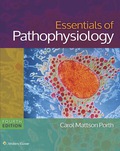
A.
To determine: The cause of electrolyte disturbance in a patient with AIDS and investigated with Pneumocystis carinii pneumonia.
Introduction: Pneumocystis jirovecii Pneumonia is known as Pneumocystis Carinii Pneumonia and it is a fungal infection that causes inflammation and fluid buildup in an individual’s lungs. This infection is nonseasonal and worldwide. The respiratory route probably acquires the organism.
A.
Explanation of Solution
Pneumocystis jirovecii pneumonia is often associated with hyponatremia, a kind of dyselectrolytemia, and the level of sodium significantly correlates to the overall outcome of the patient. It is a condition in which the serum sodium levels are less than 135 mEq/L, which results in intracerebral osmotic fluid shifts, brain edema, and several neurological complications.
Hyponatremia in HIV is associated witha syndrome of inappropriate ADH secretion, and common association is with Pneumocystis jirovecii. This yeast-like
B.
To determine: The five cardial features of low serum sodium level and having AIDS.
Introduction: Hyponatremia is the disorder of electrolyte balance and body fluid in patients having Pneumocystis carinii infection along withHIV infection. A cardinal symptom or cardinal sign is the primary or significant clinical sign or symptom by which a diagnosis is made.
B.
Explanation of Solution
Pneumocystis carinii pneumonia is an opportunistic infection that occurs in immunosuppressed populations having a CD4+ T cell count below 200 cells per µL.
Cardinal findings of patients with immune deficiency disorders who are at particular risk for Pneumocystis carinii pneumonia include thymic dysplasia, cytomegalovirus retinitis, Kaposi sarcoma, oesophageal candidiasis, and Toxoplasma encephalitis. Development of hypogammaglobulinemia with low arterial oxygen tension, arterial pH usually increased, and carbon dioxide retention also occurs.
Want to see more full solutions like this?
Chapter 8 Solutions
EBK ESSENTIALS OF PATHOPHYSIOLOGY
 Human Anatomy & Physiology (11th Edition)BiologyISBN:9780134580999Author:Elaine N. Marieb, Katja N. HoehnPublisher:PEARSON
Human Anatomy & Physiology (11th Edition)BiologyISBN:9780134580999Author:Elaine N. Marieb, Katja N. HoehnPublisher:PEARSON Biology 2eBiologyISBN:9781947172517Author:Matthew Douglas, Jung Choi, Mary Ann ClarkPublisher:OpenStax
Biology 2eBiologyISBN:9781947172517Author:Matthew Douglas, Jung Choi, Mary Ann ClarkPublisher:OpenStax Anatomy & PhysiologyBiologyISBN:9781259398629Author:McKinley, Michael P., O'loughlin, Valerie Dean, Bidle, Theresa StouterPublisher:Mcgraw Hill Education,
Anatomy & PhysiologyBiologyISBN:9781259398629Author:McKinley, Michael P., O'loughlin, Valerie Dean, Bidle, Theresa StouterPublisher:Mcgraw Hill Education, Molecular Biology of the Cell (Sixth Edition)BiologyISBN:9780815344322Author:Bruce Alberts, Alexander D. Johnson, Julian Lewis, David Morgan, Martin Raff, Keith Roberts, Peter WalterPublisher:W. W. Norton & Company
Molecular Biology of the Cell (Sixth Edition)BiologyISBN:9780815344322Author:Bruce Alberts, Alexander D. Johnson, Julian Lewis, David Morgan, Martin Raff, Keith Roberts, Peter WalterPublisher:W. W. Norton & Company Laboratory Manual For Human Anatomy & PhysiologyBiologyISBN:9781260159363Author:Martin, Terry R., Prentice-craver, CynthiaPublisher:McGraw-Hill Publishing Co.
Laboratory Manual For Human Anatomy & PhysiologyBiologyISBN:9781260159363Author:Martin, Terry R., Prentice-craver, CynthiaPublisher:McGraw-Hill Publishing Co. Inquiry Into Life (16th Edition)BiologyISBN:9781260231700Author:Sylvia S. Mader, Michael WindelspechtPublisher:McGraw Hill Education
Inquiry Into Life (16th Edition)BiologyISBN:9781260231700Author:Sylvia S. Mader, Michael WindelspechtPublisher:McGraw Hill Education





